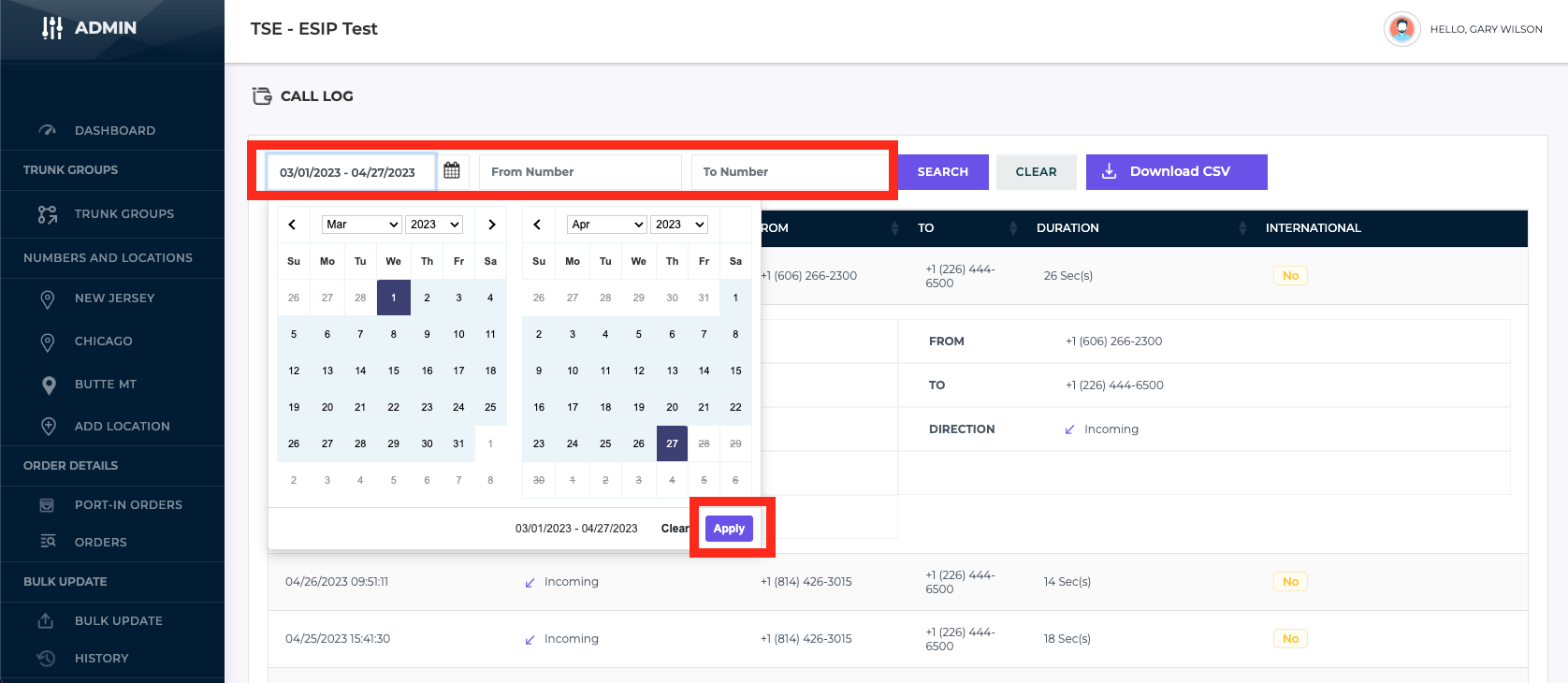User Guide for your Enterprise SIP Trunking Portal
The Enterprise SIP Trunking portal features
The features of this portal make it easy for you to self-manage your telecom services. From the Enterprise SIP Trunking portal, you can:
- Buy new local numbers
- Buy new Toll Free numbers
- Ensure a default 911 address is available for each number
- Add CNAM to each number
- Enter your own orders to port in numbers you may already have that you would like to use with the service
- Create and manage new billing locations
- Move numbers between trunk groups or TF routes and billing locations
- Create accounts for other users in your company that you would like to help manage your services
- View call logs
- View your bills
- and Create support tickets with Sinch.
Numbers you purchase can be added to any of your trunk groups and become immediately available for use, making our solution super easy for anyone looking to gain full control over day-to-day telecom operational needs.
Account Creation
When your account is ready to use, you'll receive an email inviting you to create your portal account. The link in the email will take you directly to the account sign-up page.
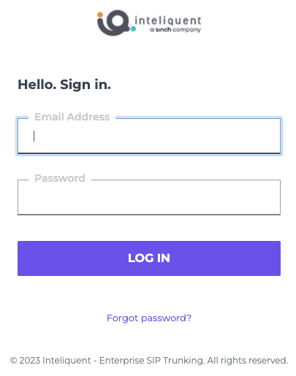
Once you are signed up, come back anytime to:
https://portal.esip.inteliquent.com/
and login again to resume managing your services.
Dashboard
The Dashboard displays the count of local and toll free numbers that are on your account.
NOTE: During the initial ordering processing, some numbers may already be on your account. You can review those and decide if you want to keep them or return them and buy new numbers.
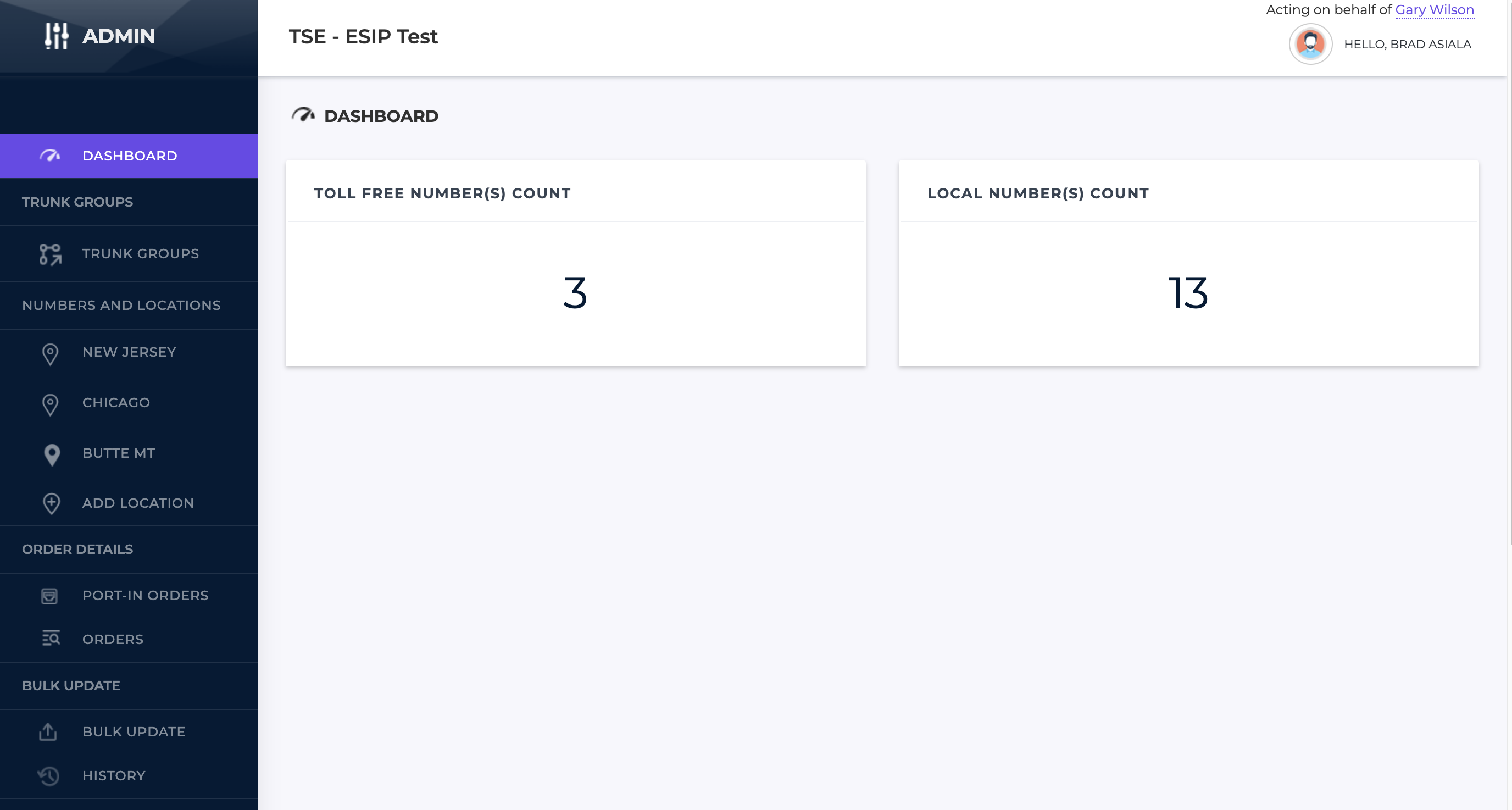
You’ll use the navigation menu on the left to complete other activities, such as monitor usage, request new numbers, and manage your SIP trunking service.
Trunk Groups
Select Trunk Groups on the left navigation menu to view or manage existing trunk groups. There are two tabs: one for Trunk Groups (usually DID trunks) and one for Routing Labels for use with Toll Free numbers.
Trunk Groups Tab
You’ll initially see an overview of existing trunk groups, and each will have the pencil icon allowing you to make any necessary changes. The trunk groups are added to your portal during the onboarding process.
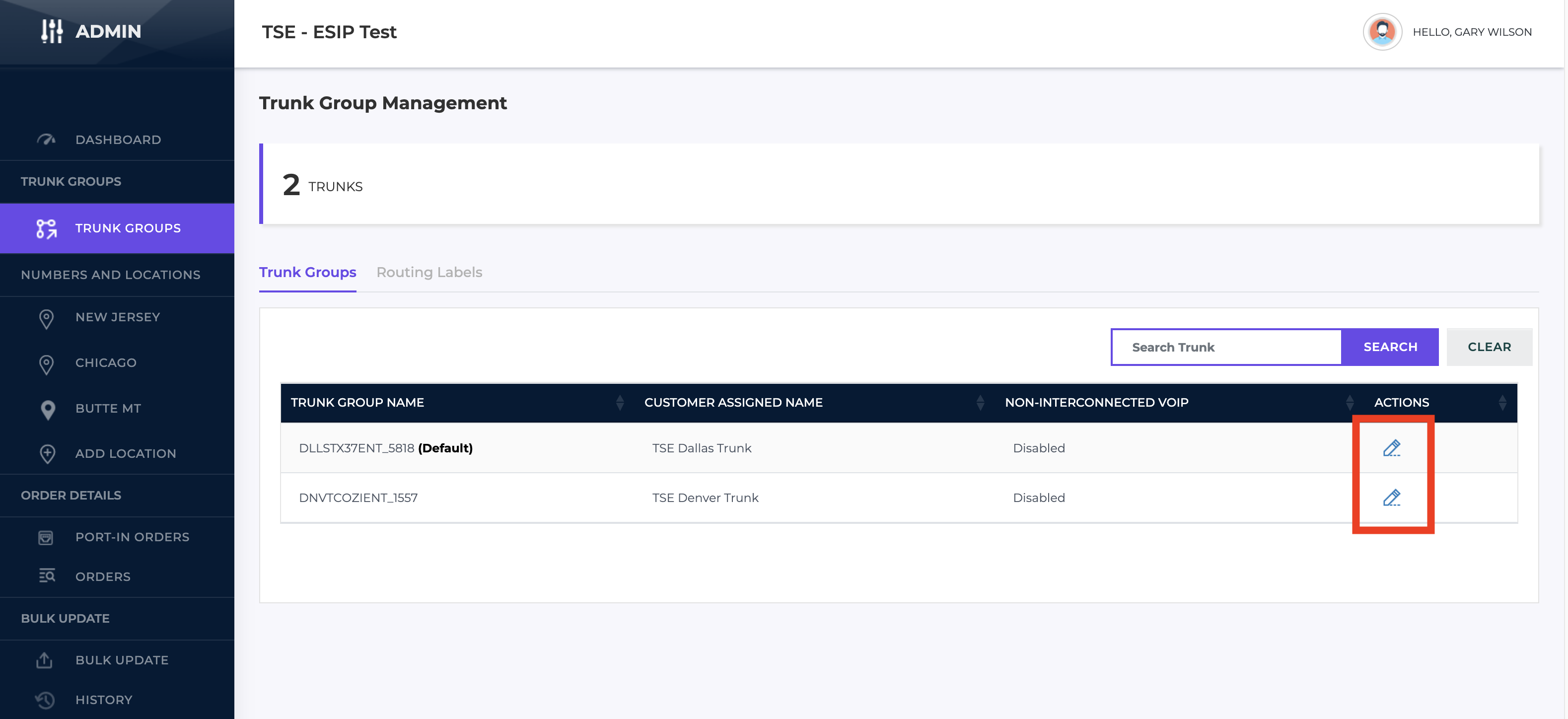
When you edit a trunk group, there are only a couple things you can change. The other fields are preset for you. The first option is adding a Customer Assigned Name to your trunk group. This is a name you add to make it easier to identify which trunk this is when assigning numbers or in other operations as you'll see later.
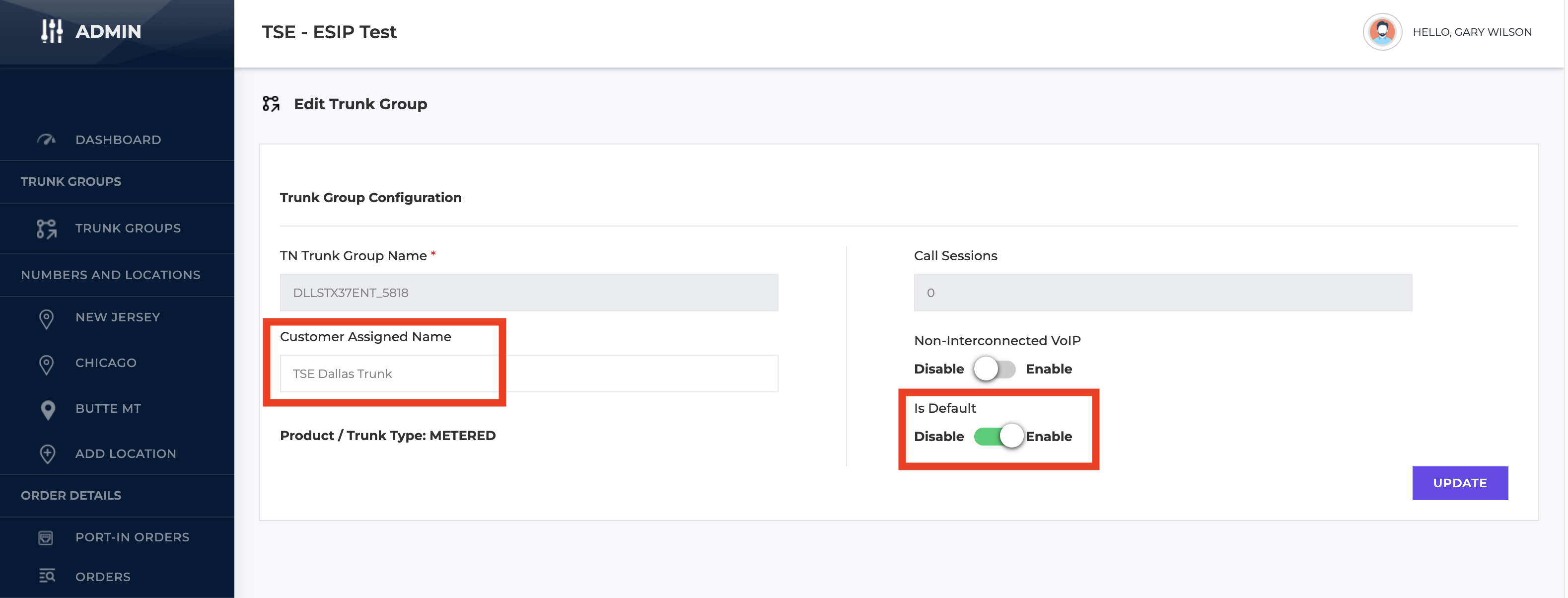
The other option above is to make this trunk group the Default. If you frequent add most of your numbers to this trunk group, this will be the default trunk when buying numbers so you don't have to choose the right one every time. This will be covered in the Buying Numbers section.
Routing Labels Tab
If you have or need Toll Free numbers, routing labels will be created for you during the onboarding process and entered here for you. Like with Trunk Groups, you have the same two options when editing a label.
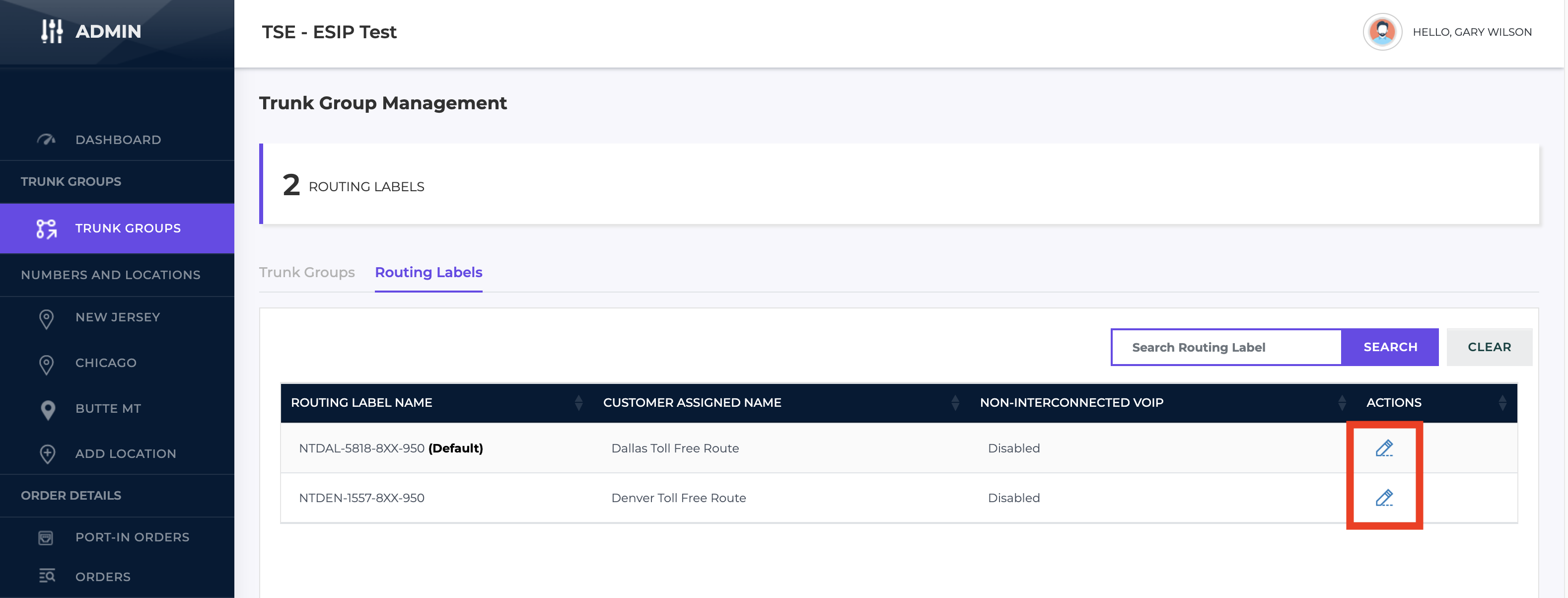
Enter a Customer Assigned Name to provide your own name for the trunk groups, and decide which one should be the default when ordering toll free numbers.
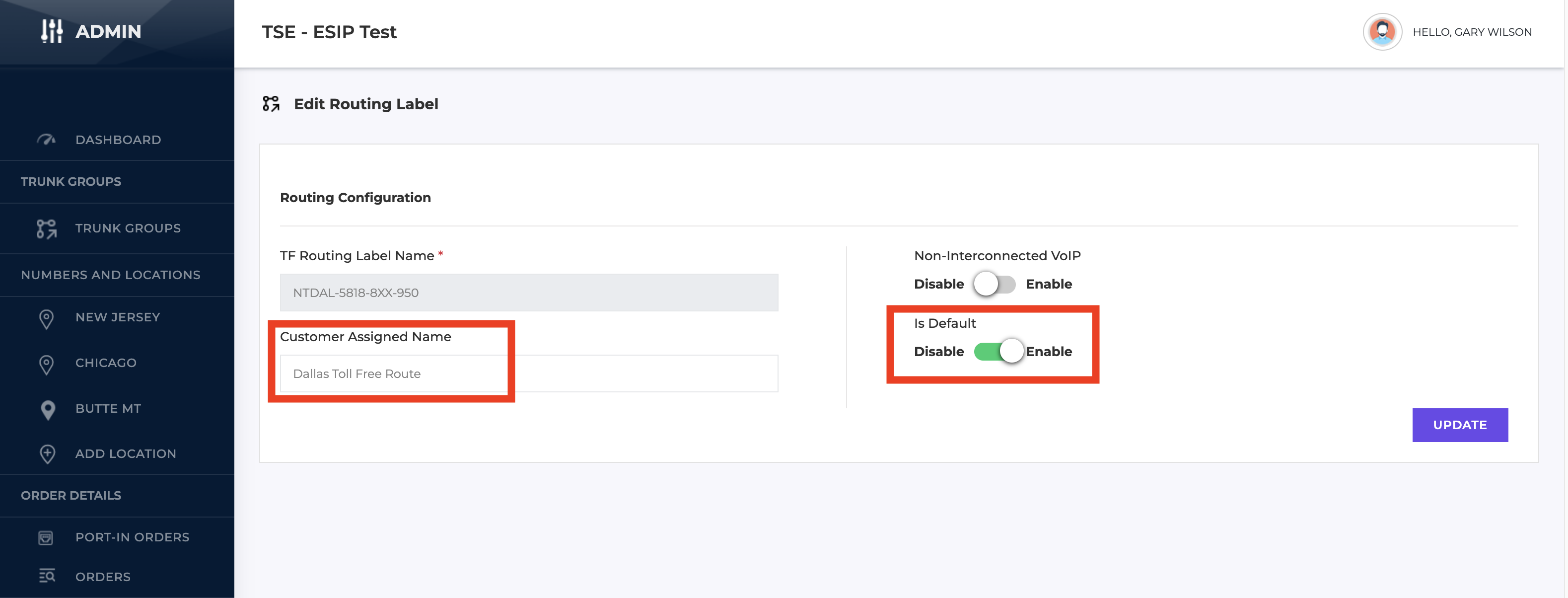
Numbers and Locations
Selecting the Numbers and Locations option on the left navigation menu opens the dashboard for managing individual numbers and the locations of your offices or facilities. To view all numbers across all locations, select the main Numbers and Locations menu item. The view will show all numbers and include a Location column. If you select a specific location, only numbers in that location will show.

When you first log into your portal, you will likely only see one location, which would typically be the initial location the first order was placed for. Any numbers from the original order would be added to this location.
NOTE: Locations are a key distinction in that these are more than just a helpful designator for organizing your number inventory. They are also a billing element. On your monthly invoices, services will be broken down by the locations you have entered, including any taxes for the services based on those locations.
When you are in any of the locations (or the main one), there are three tabs for your Local Numbers (DIDs), Toll Free Numbers, and if you return a number, a tab to view and restore Local Numbers if you decide within 60 days that you would like that number back.
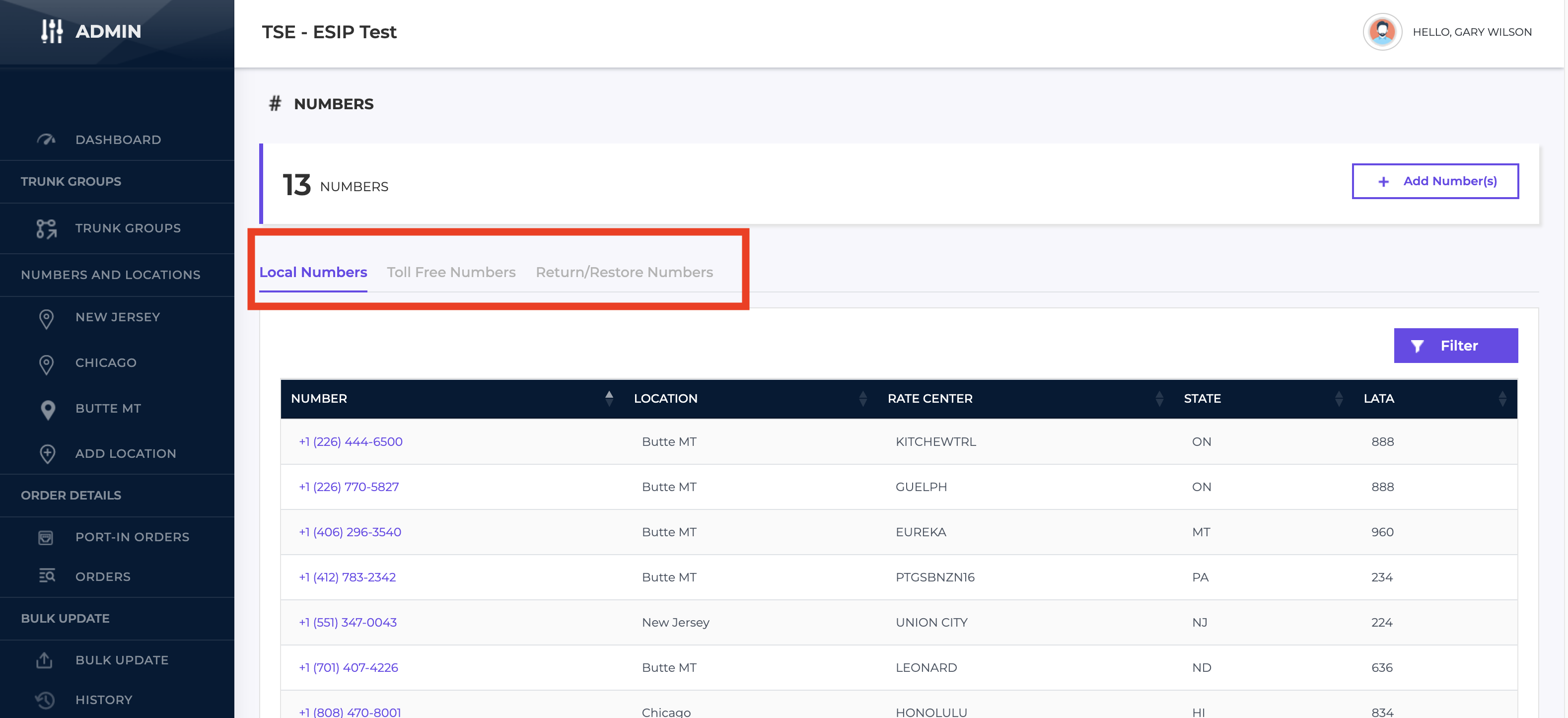
Adding a Location
Click Add Location on the left navigation menu, under the Numbers and Locations header. Fill in the address info in the Add Location dialog. Note that you need to separate out the Street Number from the Street Name. For any options like Room # or other options that are not part of the main street address, enter that in the Location section if needed. The Location field is generally more important when adding address information for E911 on a specific number rather than here which is primarily for main location and billing support. E911 addresses will be covered in another section on adding to numbers.
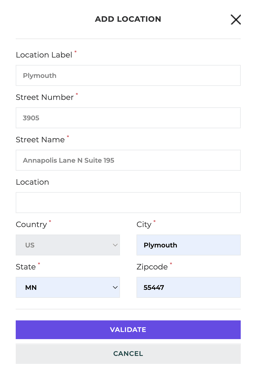
Next, click Validate. Any corrections will be made and shown prior to creating the location.

Click OK to accept the changes. The location dialog is updated with the suggested changes. You can further Edit the address or click Add to add this address to your list of locations.
Editing Existing Local Numbers
When viewing your list of local or toll free numbers, clicking the number allows you to edit various features and settings on the number.
Editing Local Numbers
The first option you can change is which Location the number is assigned to. Once changed, this will affect billing and taxation for the number and usage going forward. Any previous billing and taxation would be applied to the old location.
The next option lets you reassign which trunk group this number is assigned to. If you have multiple trunks groups and have a trunk down, or know you'll be doing maintenance but still want calls to route, you can reassign this number to another one of your working trunk groups.
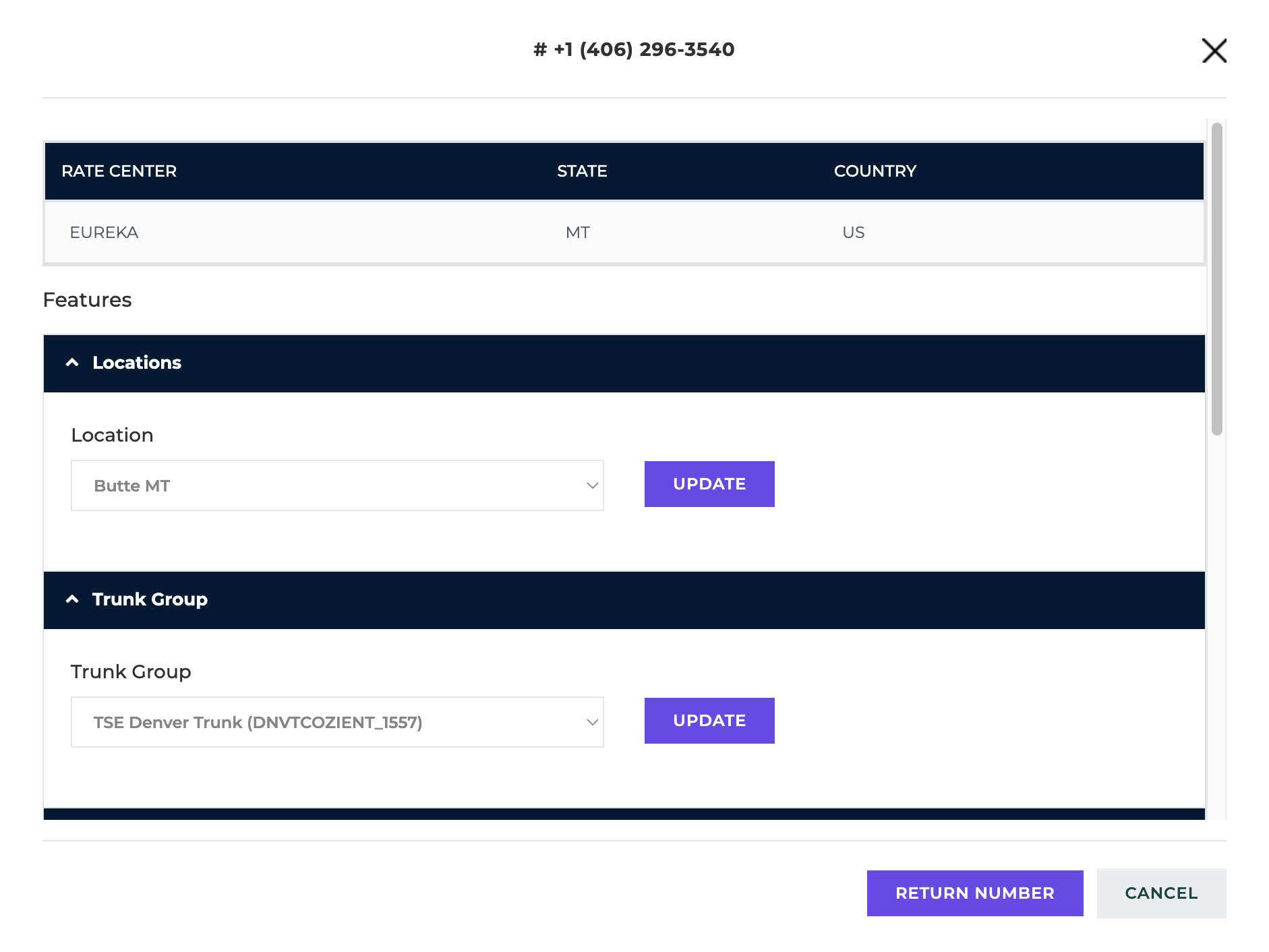
The next section lets you add an E911 address for this number. Move the slider to Enable, then fill in the address fields. The Emergency Contact can be the company name or specific person this number is assigned to in your PBX. Use the Location field to enter more specific information such as a room number where the phone this number is assigned to is located.
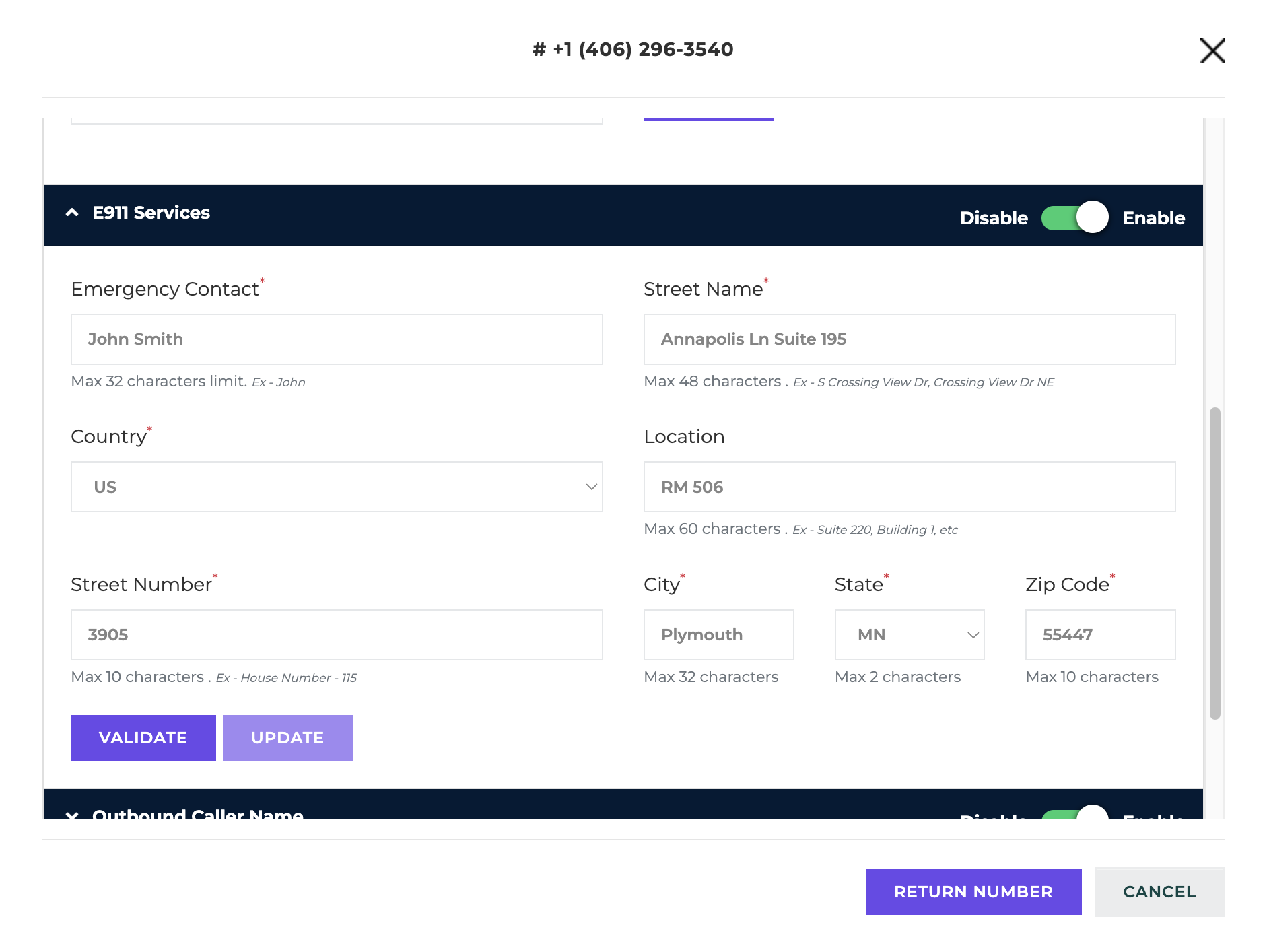
Next, click Validate to determine if the address is valid or if there are corrections available.
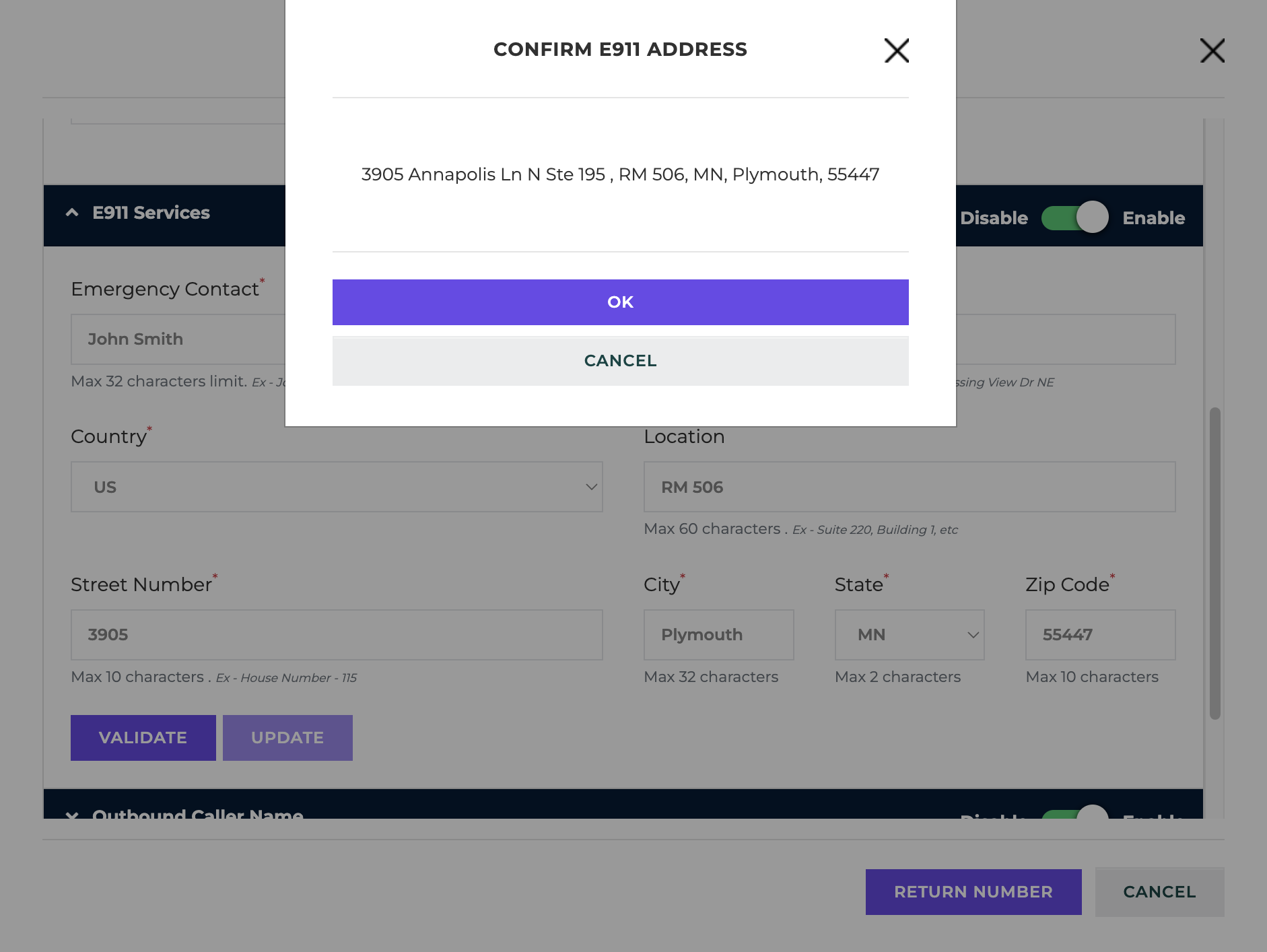
Then click OK to apply any corrections to your address info. Next, click Update to add this E911 address entry to this number.
To change an existing entry on a number, move the slider to Disable. You will be prompted to click Disable again to remove this entry from the number. Once removed, move the slider to Enable again and enter the new address info.
Note that once an E911 address has been added to a number, additional required E911 taxes and charges will be applied based on the location the number has been assigned to.
The next section lets you set an Outbound Caller Name (CNAM) that would be seen by users when the user assigned this number places an outbound call. To set this, move the slider to Enable, enter the Outbound Caller Name (max 15 characters per PSTN standards) and click Update to apply. Move the slider to Disable to remove CNAM for this number. You can update the CNAM at any time, though CNAM updates can take several days to roll out to most carriers. The updates must be picked up by the terminating carriers, that is, the destination carrier serving the person you are calling. If the person you are calling is reporting no caller name or the wrong caller name, wait for several days to ensure the CNAM update has had sufficient time to be picked up.
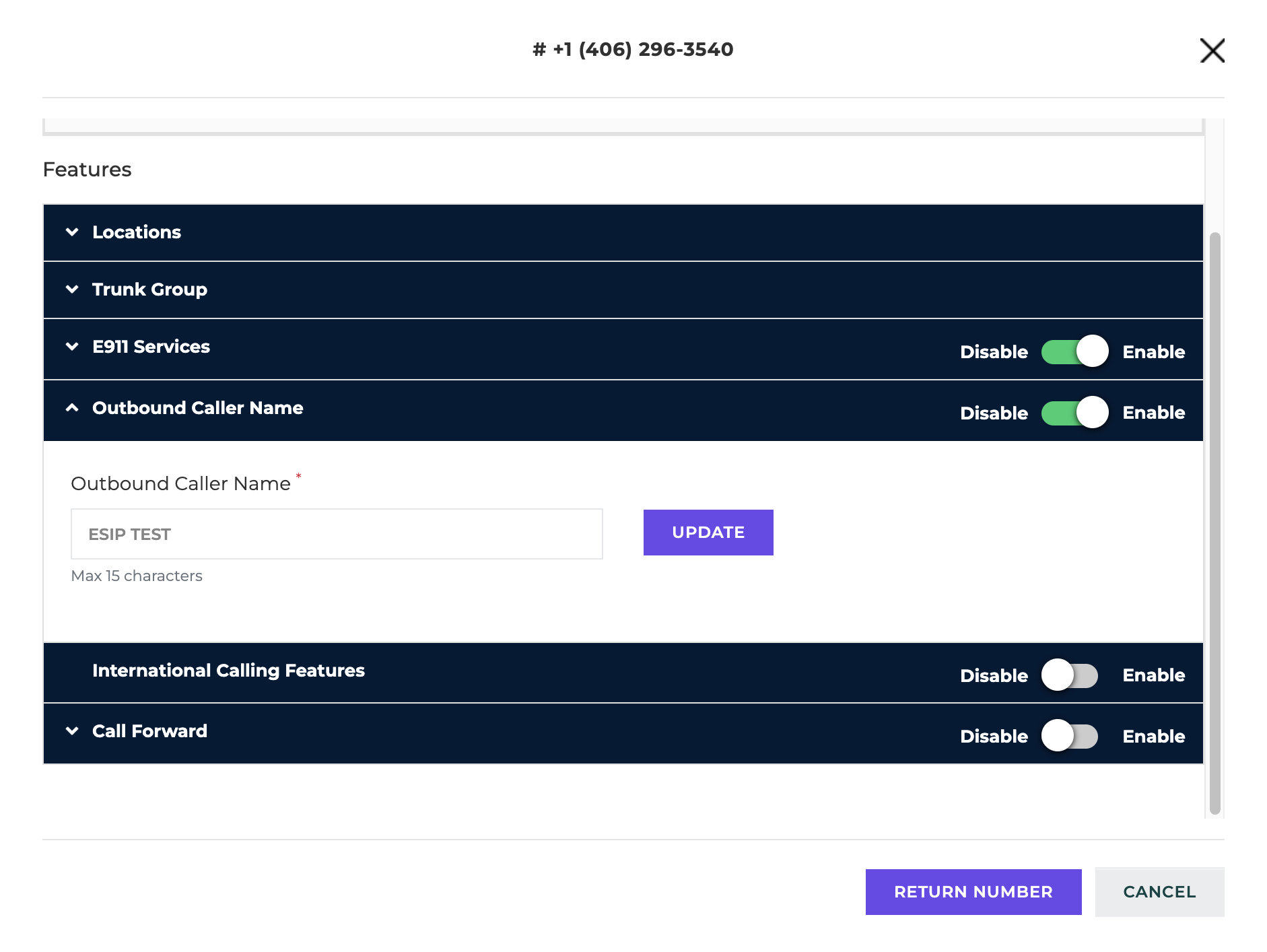
The final two sections are optional and depend on if these have been enabled for you.
The International Calling Features determines if the user assigned this number on your PBX can place calls to international numbers. The default is US destinations. If this option is available to you, and you want to allow international calling, move the slider to the Enable position.
The Call Forward feature allows you to forward calls to this number to a different 10-digit number. For example, if this is your main number and your PBX is down, you can forward the number to another destination until you can restore service. To enable this feature if it's enabled for you, move the slider to the Enable position. Click the arrow to expand the section and enter the 10-digit number you want to forward calls to. Click Update to apply the forward. To turn off call forwarding, move the slider to the Disable position.
At the bottom of this dialog box is another option - Return Number. If you no longer need this number, you can simply return it. The number will be removed from billing going forward. Returned numbers show in the Return/Restore Numbers tab. Local Numbers have the ability to be restored to service for up to 60 days. Click Restore to add this number back to your account.
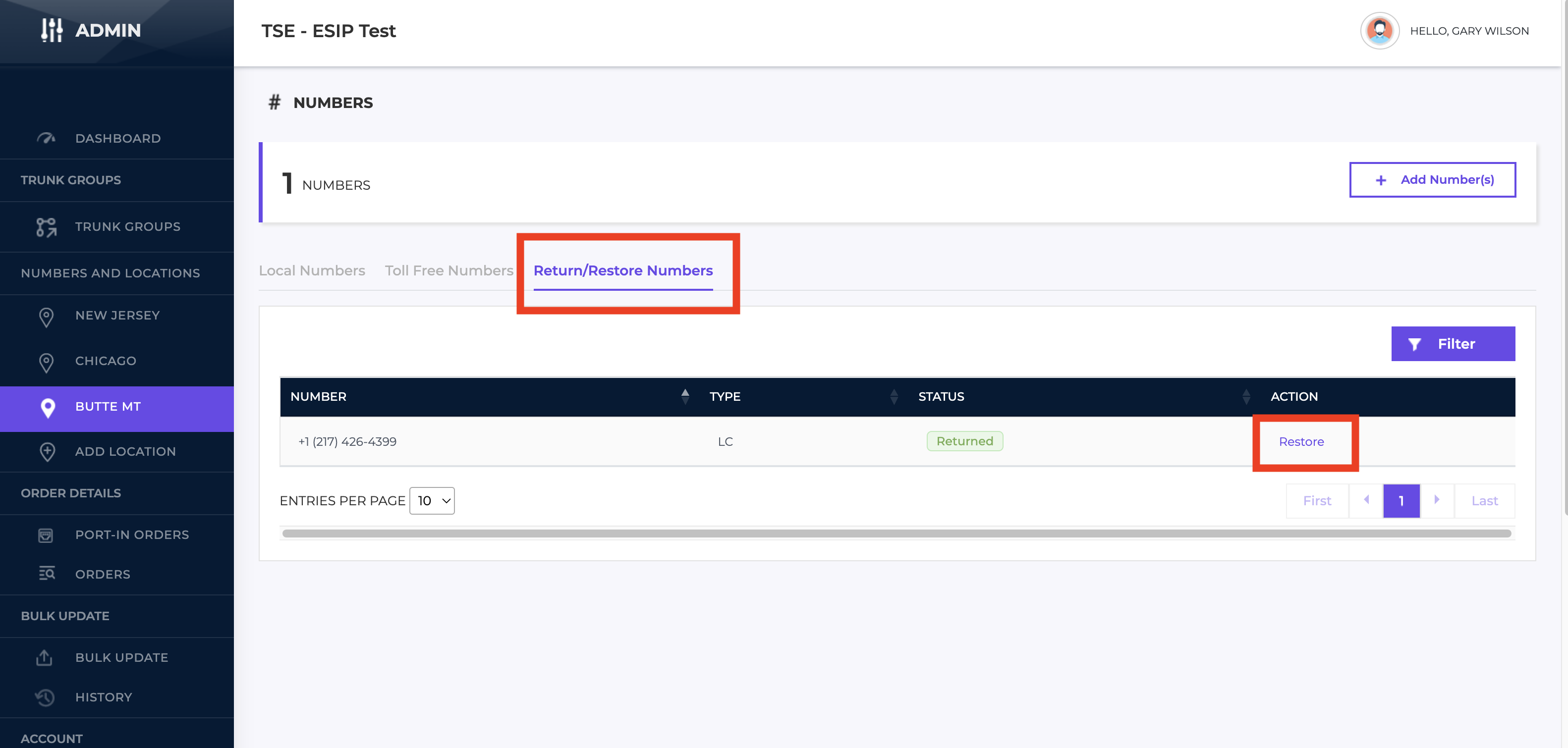
Editing Toll Free Numbers
In your list of Toll Free numbers, click the number to edit it. The first option you can change is which Location the number is assigned to. Once changed, this will affect billing and taxation for the number and usage going forward. Any previous billing and taxation would be applied to the old location
The next option lets you reassign which route label this number is assigned to. If you have multiple routes and one is down, or know you'll be doing maintenance but still want calls to route, you can reassign this number to another one of your working routes.
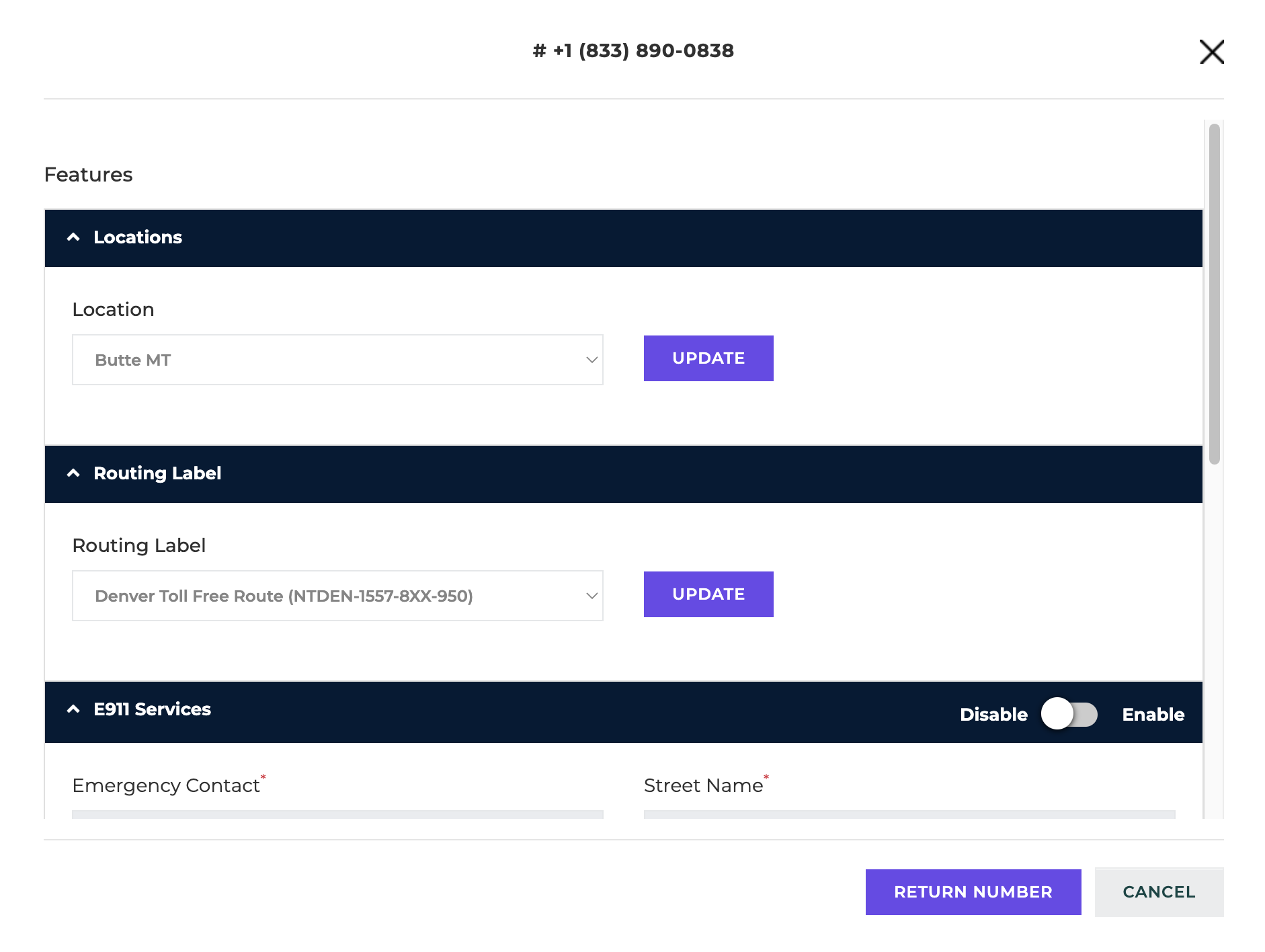
Just like for local numbers, you can add an E911 entry for a Toll Free number in case you have assigned one as the number sent out when user(s) call 911. See the section in Editing Local Numbers on how to apply E911.
The same thing applies to Outbound Caller Name. Adding one is the same as in the Editing Local Number section above.
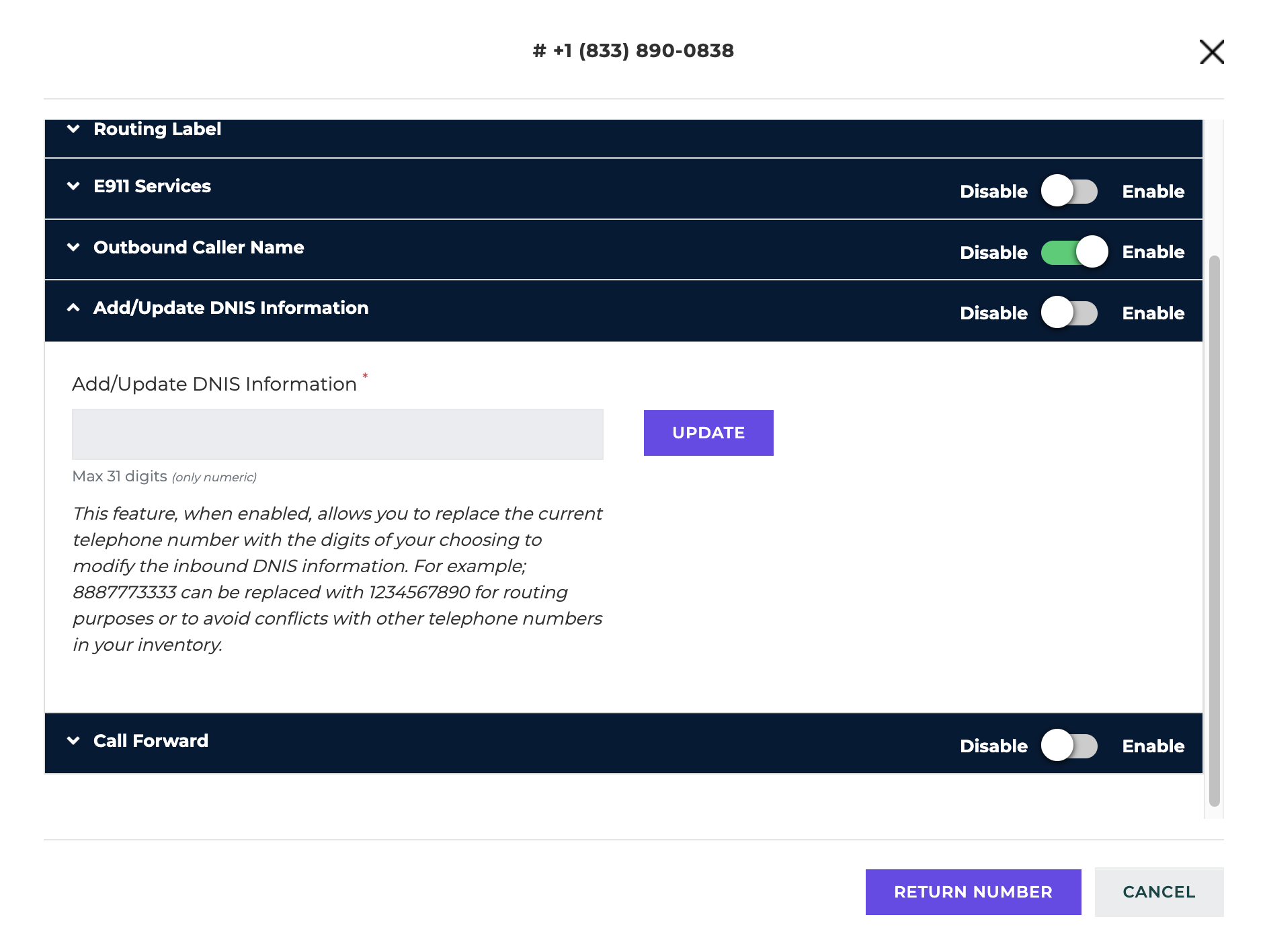
For Toll Free numbers, you can add a DNIS string to replace the Toll Free number. Move the slider to the Enable position, enter the DNIS digits you would like to receive and click Update to add this service. To turn if off, move the slider to the Disable position.
The Call Forward feature is also available for Toll Free numbers and allows you to forward calls to this number to a different 10-digit number. For example, if this is your main number and your PBX is down, you can forward the number to another destination until you can restore service. To enable this feature if it's enabled for you, move the slider to the Enable position. Click the arrow to expand the section and enter the 10-digit number you want to forward calls to. Click Update to apply the forward. To turn off call forwarding, move the slider to the Disable position.
At the bottom of this dialog box is another option - Return Number. If you no longer need this number, you can simply return it. The number will be removed from billing going forward. Returned numbers show in the Return/Restore Numbers tab.
NOTE: Toll Free Numbers cannot be restored once returned..
Buying Numbers
To order new local numbers, choose the Numbers and Locations menu or click any Location, then click Add Number(s) in the upper right.
To order new Local Numbers, set the Number Type to Local. To order new Toll Free numbers, set the Number Type to Toll Free.
Extensive search options are provided to help you find the right numbers for your business.
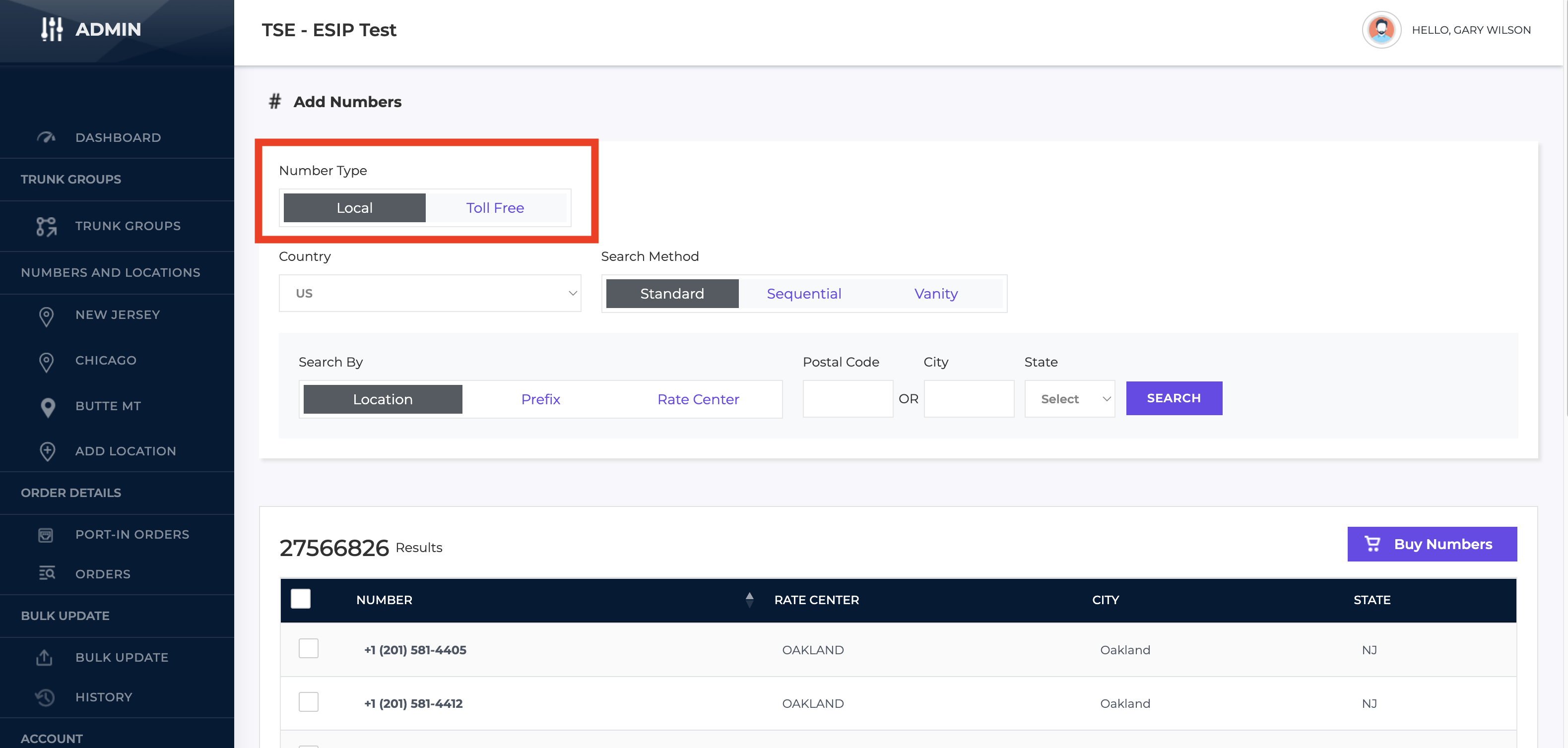
Local Numbers
To order US numbers, set the Country to US (default). The State list will be updated to include the 50 states and the District of Columbia. If you need Canadian numbers, set the Country to Canada and the State list will be updated to include the Canadian Provinces.
Other options like Sequential let you retrieve a list of numbers that are numerically sequential by the last 4 digits. The Max Size defaults to looking for 10 sequential numbers.
You can also search by Prefix or Rate Center.
The Vanity search option lets you enter a Phrase and a Position on where the phrase should match.
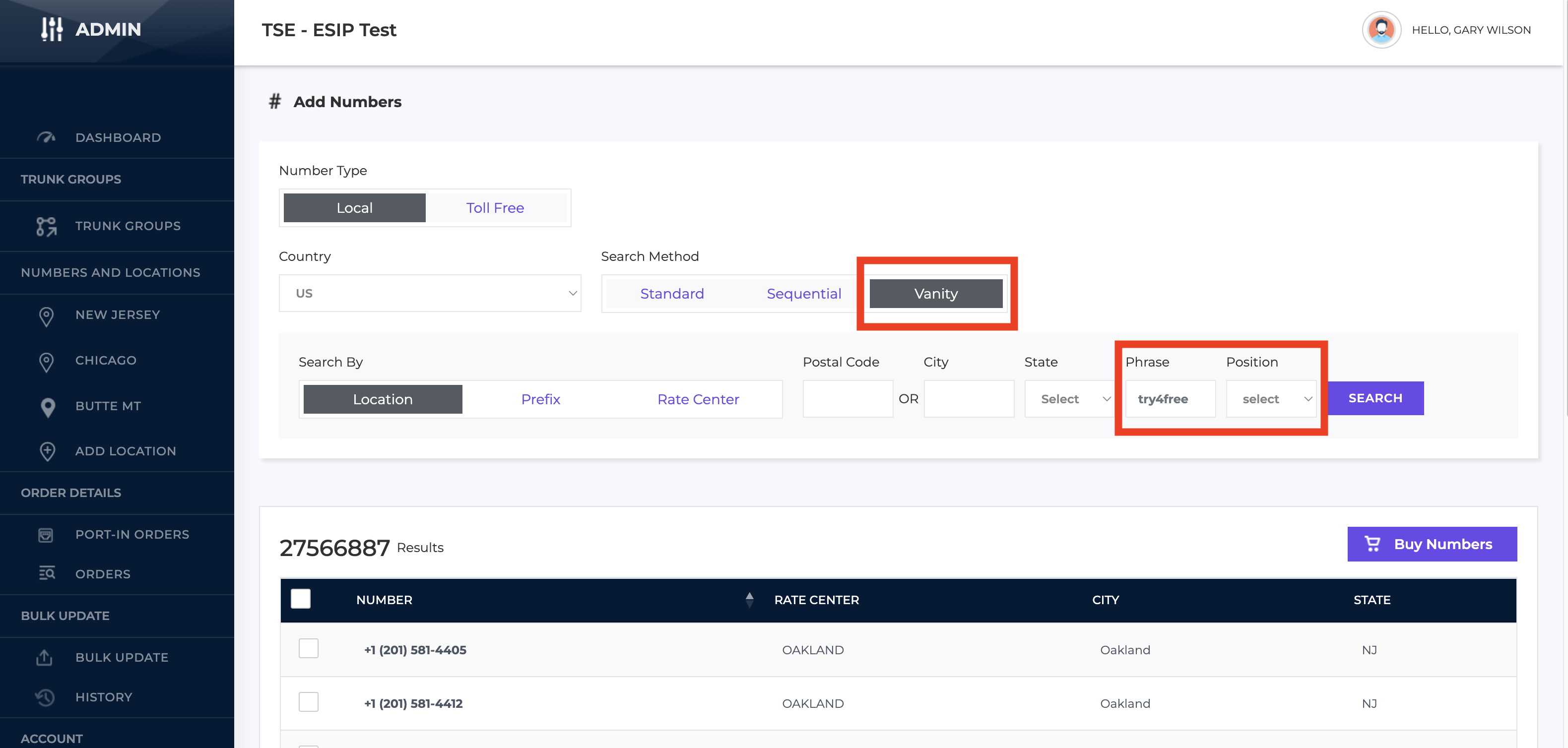
Toll Free Numbers
To order Toll Free Numbers, choose Toll Free as the Number Type. You can choose a Prefix to search, in addition to looking for sequential ranges or Vanity options as well.
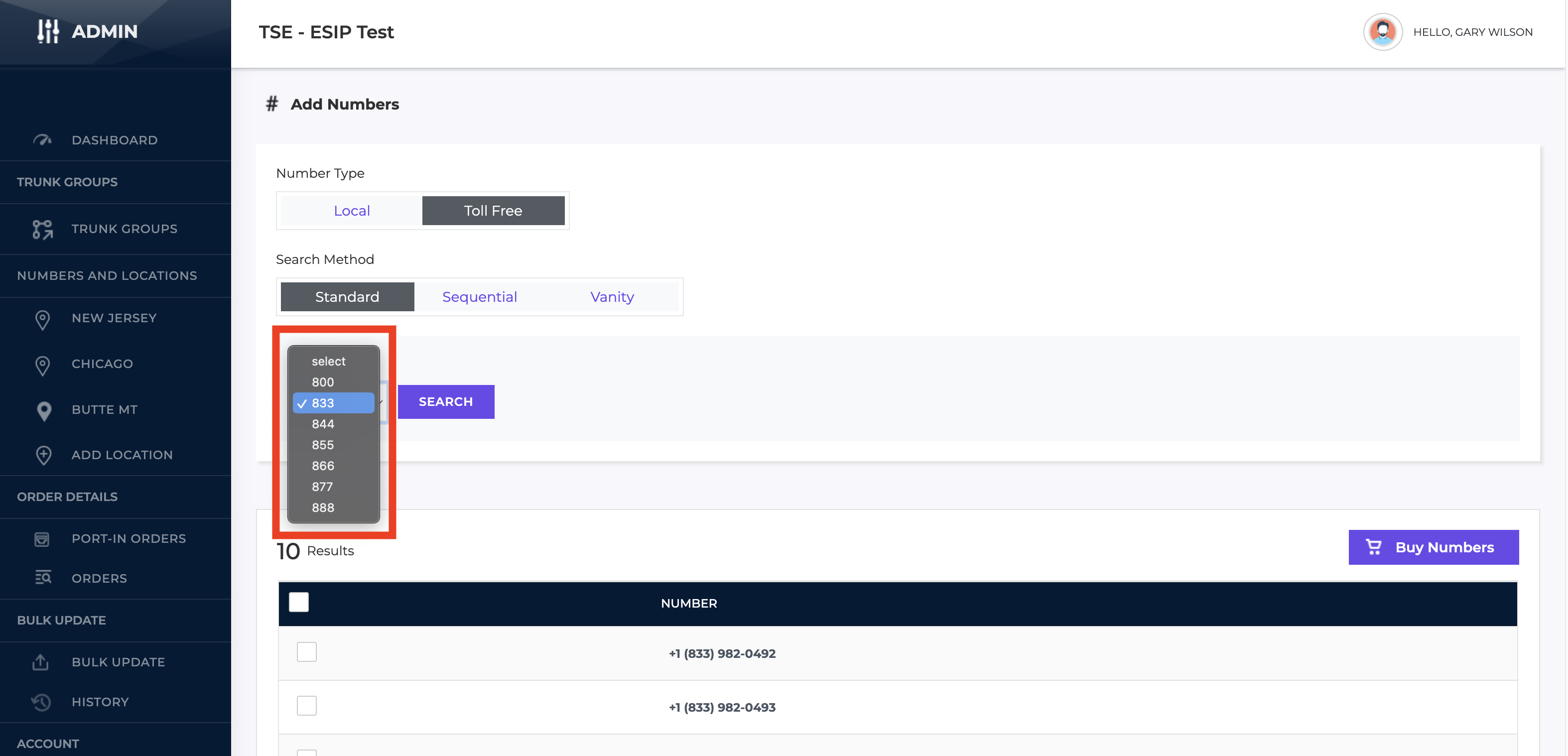
Once you have a list of numbers that meet your search criteria, choose them from the list at the bottom by clicking the check box next to each number, then click on Buy Numbers. If you want to select all the numbers on the page, click the check box on the Number header bar.
Adding options to your number(s)
Once you choose Buy Numbers, you'll be provided an option to add a Location, Trunk Group (for Local Numbers), Route Label (for Toll Free numbers), E911 and Outbound Caller Name (CNAM) to the numbers. For Toll Free numbers, you can also add a DNIS string during the buying step.
The only mandatory options to choose when buying numbers is to select a Location for the services and to either choose a Trunk Group for Local Numbers (note the Default trunk group is automatically chosen) or a Route Label for Toll Free numbers (note the Default route label is automatically chosen).
You can add or change the E911, CNAM or DNIS for any number by going to by following the steps in Editing Existing Numbers above.
Order Details
The Order Details menu has two sub-options that allow you to create Port-In Orders and view completed Orders.
Port-In Orders
We'd love for you to adopt our service, so of course we've made number porting easy for you to do and fully under your control. Ordering and testing a few numbers on your account lets you determine how well the service will work for you and your employees. When are you ready to move your existing numbers over, click on the Port-In-Orders menu to begin.
If you've had any previous port-in orders, they will be listed here including any complete or pending orders. Click the order number to open any existing port order.
Creating a Port-In Order
Initially this page will not contain any existing port-in orders. To start a new port-in order, click the Create Order button.
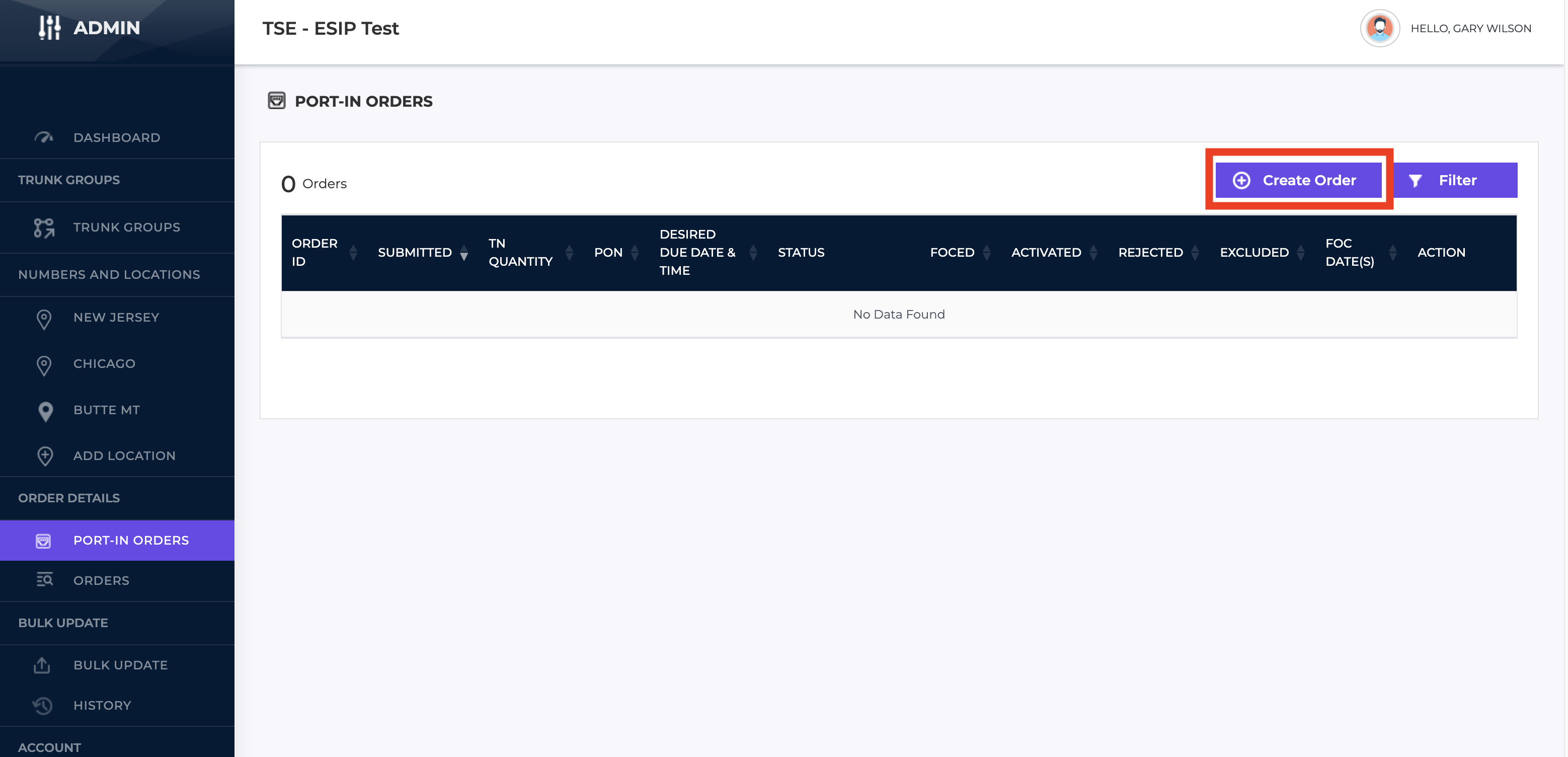
Creating an order is done in a few steps. The first step is to make sure the numbers you want to move to our services are portable, that is, the numbers can be reassigned from your current carrier to us.
On the first screen, enter the numbers that you wish to port. You have several ways to enter the numbers depending on how many. If you have a few, you can just type in the 10-digit numbers in the +Add TN box on the right.
If you have them in a list such as in a column in Excel, you can select the entries and copy/paste those into the +Add TN box. The numbers should be 10-digit numbers without any 1- or +1- in front.
Optionally, you can click "here" in Download Sample CSV here at the bottom of the left-side box. This will download a CSV template that you can then add in your numbers, then import.
Once you have your numbers entered, click Validate TN in the bottom right.

The port-in availability status will be shown in the next section. If your number(s) is portable, the Is Portable column will be Yes. If not, No will be shown and a reason for why the number is not portable will be shown. You can only port numbers to our service that indicate Yes.

Click Port-In TNs to go to the next section. At the top, the list of numbers that are portable will be shown. The remainder of the entries are critical to getting your port order entered correctly and making sure the porting process is smooth.
The information you are about to fill in provides us a Letter of Authorization, or LOA that allows us to submit a request to your current carrier to port your numbers. All information in this section must exactly match the information that your current carrier has. The best option is to get your current Bill Copy from your current carrier as this should have your current Account Number/Billing Telephone Number, correct Address and other information.
The first thing to do is decide on when you want the number port to take place. For business numbers, this can take up to two weeks or longer for complex ports.
Select a FOC Time Zone, and then choose a FOC Date and Time. FOC stands for Firm Order Commitment. This is the date and time you are requesting the port to take place. Your current carrier will need to accept this request and has up to 72 hours to do so. If your current carrier accepts your requested date and time, your numbers will port then.
Optionally, you can select the On Demand check box. You must then select a FOC Time Zone and FOC Date. The On Demand option lets you trigger the number port operation any time during the agreed upon FOC day.

The next section can be filled out using your current bill copy. The information on the left must match your current carrier information. Any field with a * is required to be entered. Once you have entered the information, select the numbers in the column on the right, then click the right-facing arrow to move those over to the next column.
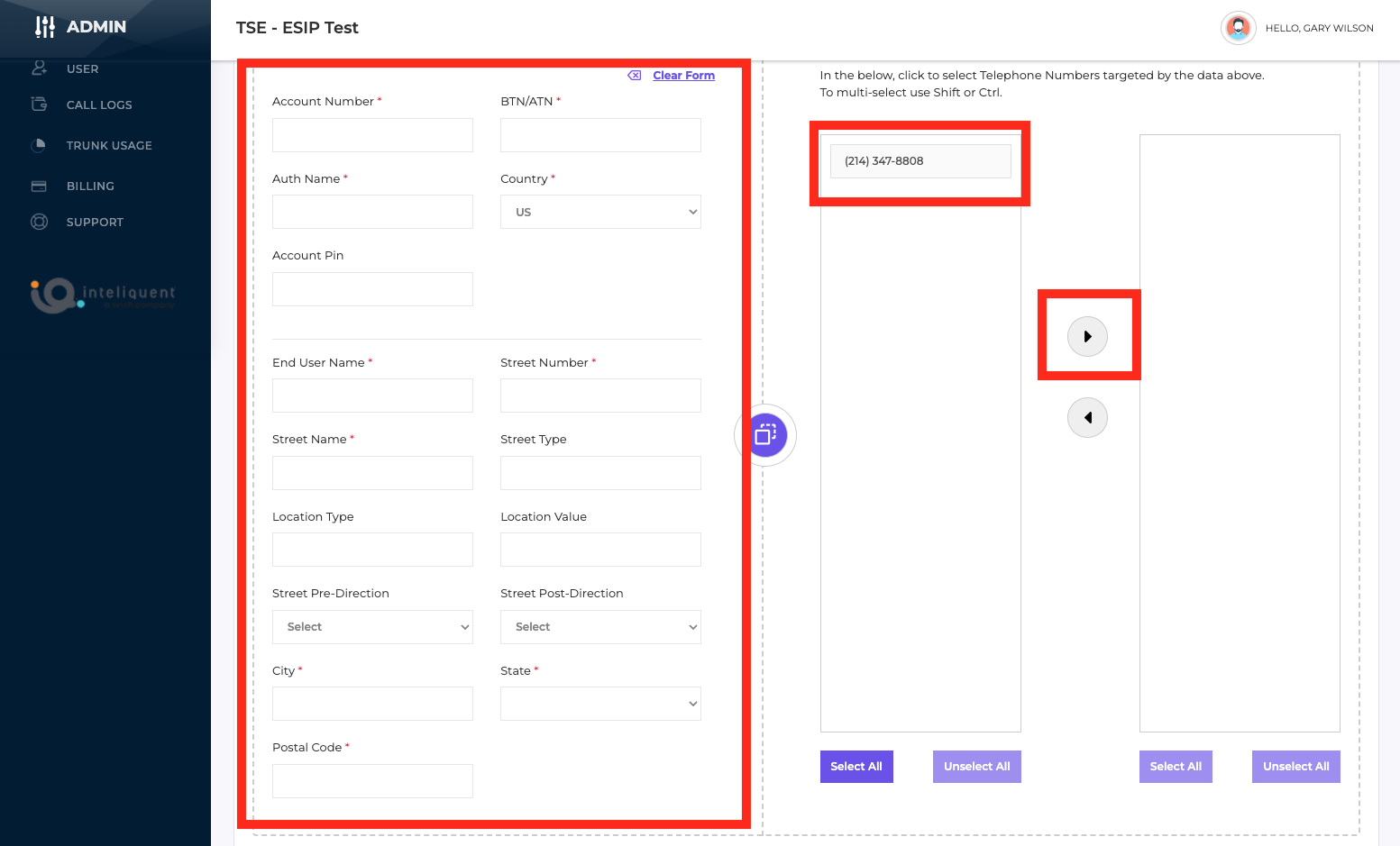
Scroll further down and you will see an area to Upload a Letter of Authorization. This is not required unless you know the carrier you are porting from requires one. If so, contact your sales rep for the latest LOA from. Fill that out, get it signed, and upload a PDF copy of the signed form here. You can also upload a Bill Copy if the other carrier asks or requires it.
Then click Next at the bottom-right to go to the order review page.
Review your port-in order to make sure the information looks correct and then submit the order.
Once your order is submitted, it will now show in your list of Port-In Orders.
Creating a Toll Free Port-In Order
To port in a Toll Free number, click the Toll Free Numbers tab, then enter the number(s) you wish to port in. Click on Port-In TFs at the bottom right.
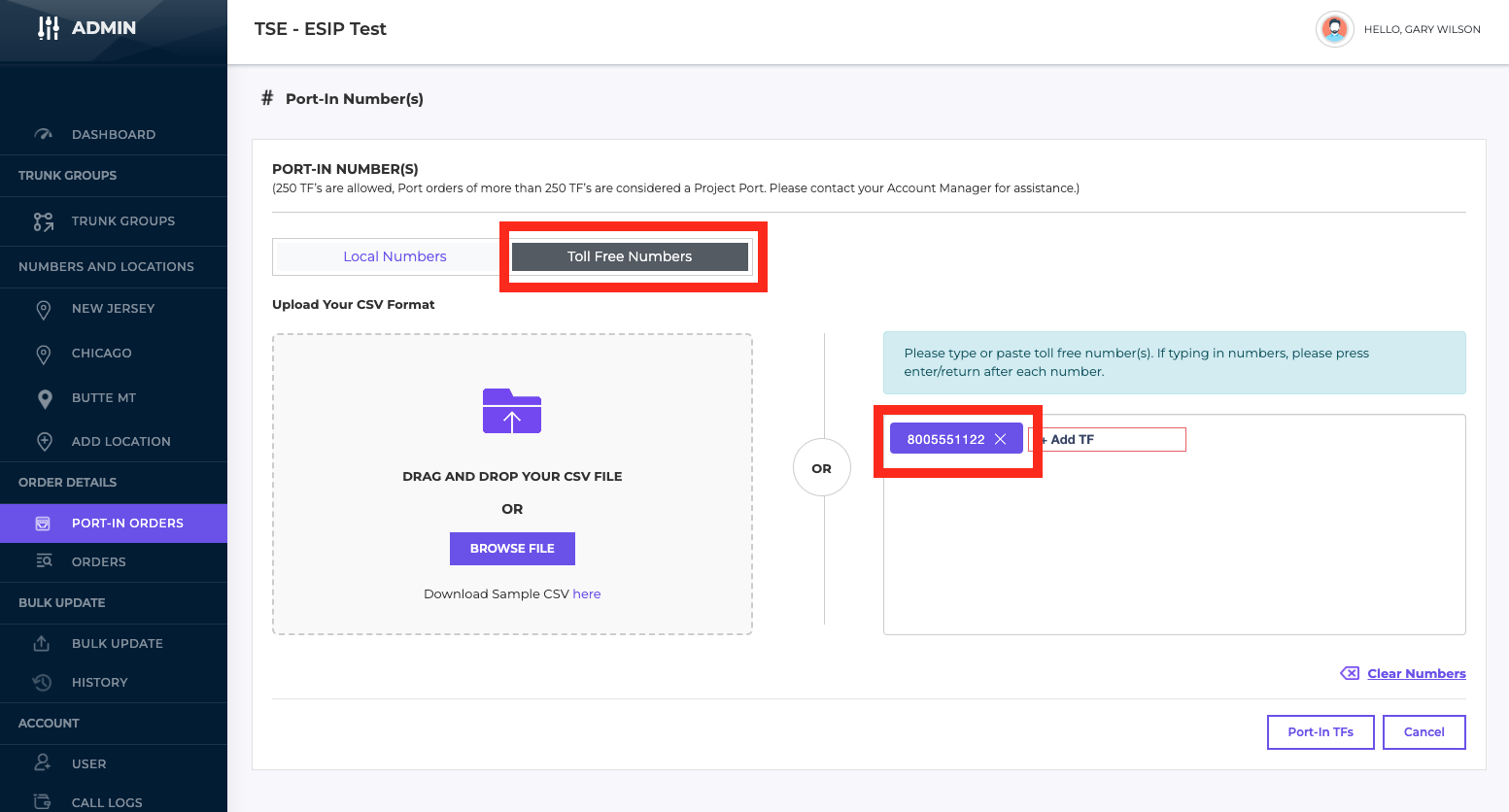
Toll Free numbers ports always require an LOA form. You must fill it out and add it to the port order.
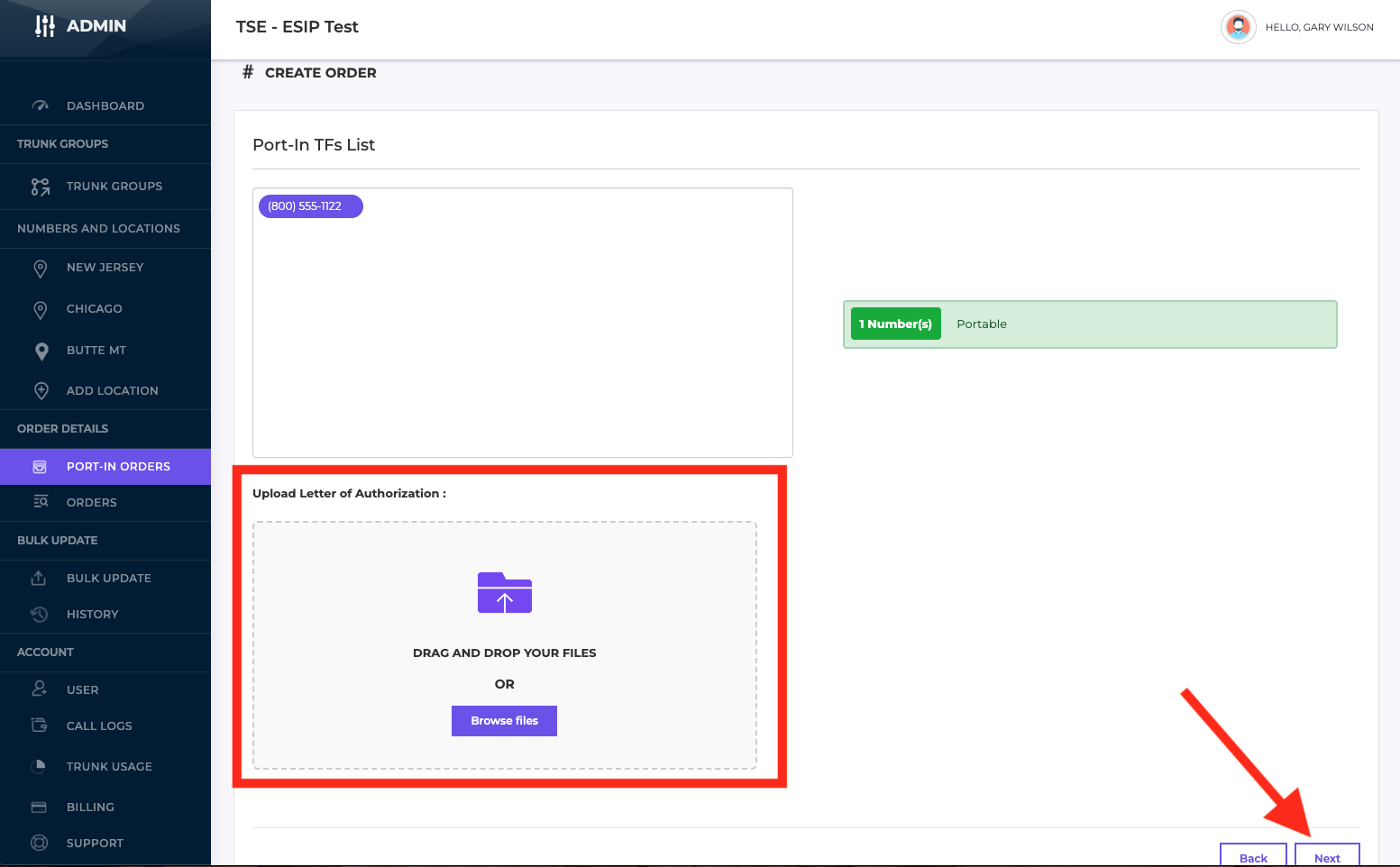
Then click Next to continue.
Review your TF port-in order to make sure the information looks correct and then submit the order.
Once your order is submitted, it will now show in your list of Port-In Orders.
Reviewing Port-In Orders
To check the status of your port-in order at any time, click the Port-In Orders menu. The Status indicates what state your port order is in. Pending means the order has not completed yet. Closed means the order is completed. Cancelled means the order has been cancelled and will no longer port. For Pending orders, the details in the other columns indicate the progression of the order. If all your numbers have a FOC confirmation, then the FOCED column quantity will match the TN Quantity column and the FOC Date(s) column will list what date/time your current carrier has accepted. This will typically be what you requested.
If your carrier has rejected your request, the number quantity will be listed in the Rejected column. To see why the port request was rejected, click the Notes icon on the far right to review any order notes. To fix up any information, click the Order ID, then click Update to make changes and resubmit.
When the port has completed, the numbers will be shown as Activated and the order status will move to Closed.
In the example below, the first order in the list is a TF port order. These orders do not have the activation or other statuses to view. The second oder is a DID order.
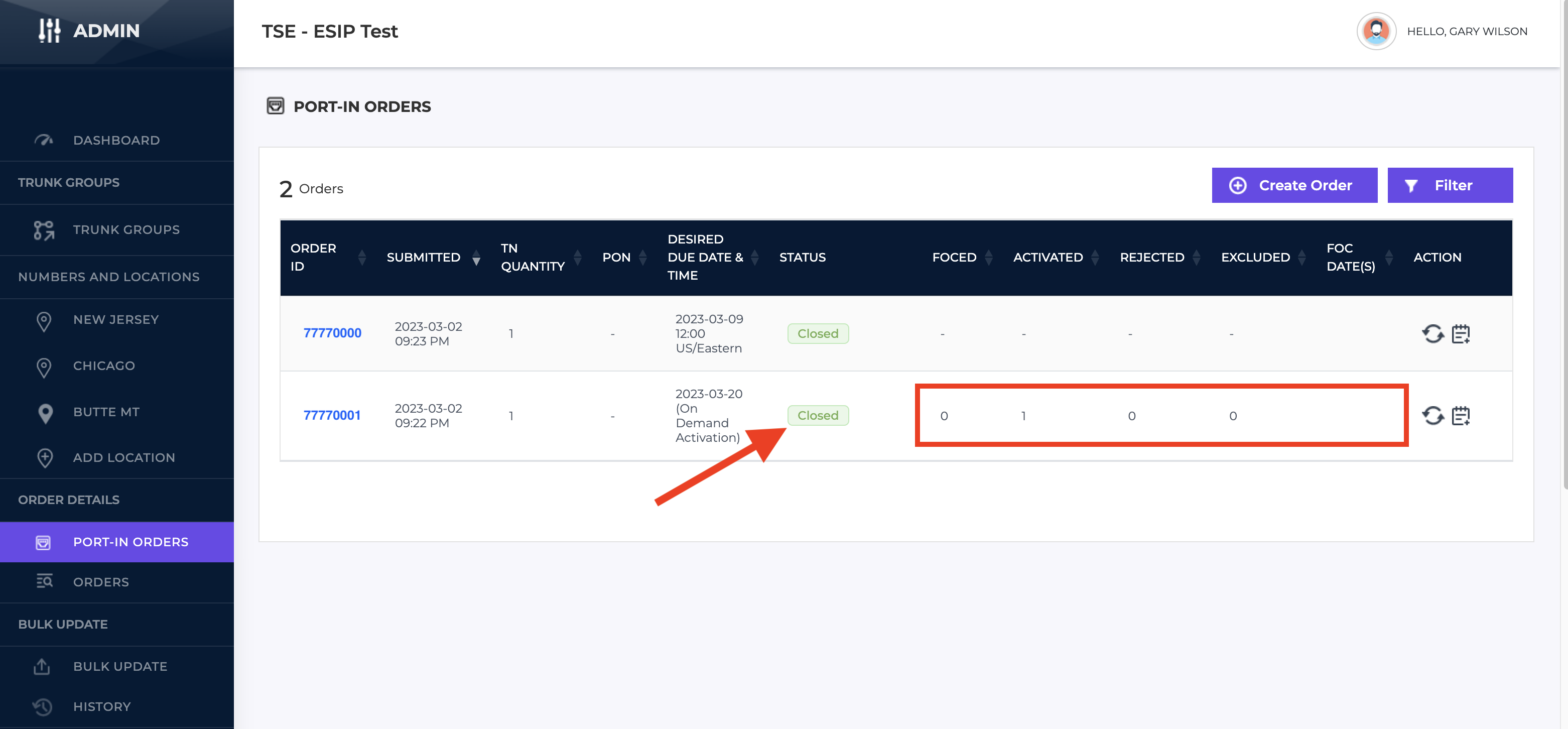
NOTE: When your numbers complete the porting request, they will be added to your number inventory and assigned to the Trunk Group or Route Label you designated as the Default.
Go to the section on Editing Existing Numbers to see how to change the trunk group, add E911, add Calling Name or other options you can set on these numbers.
Orders
Orders is the second option under the Order Details heading and displays all completed orders related to your SIP trunking services. Click anywhere on a row to expand the order and view the order information.
Bulk Update
You may need to change a large amount of numbers at once. Making these changes individually can quickly become time-consuming and error-prone, so we’ve developed a Bulk Update option for processing bulk changes.
Bulk Update
Look for the Bulk Update option under the Bulk Update menu heading.
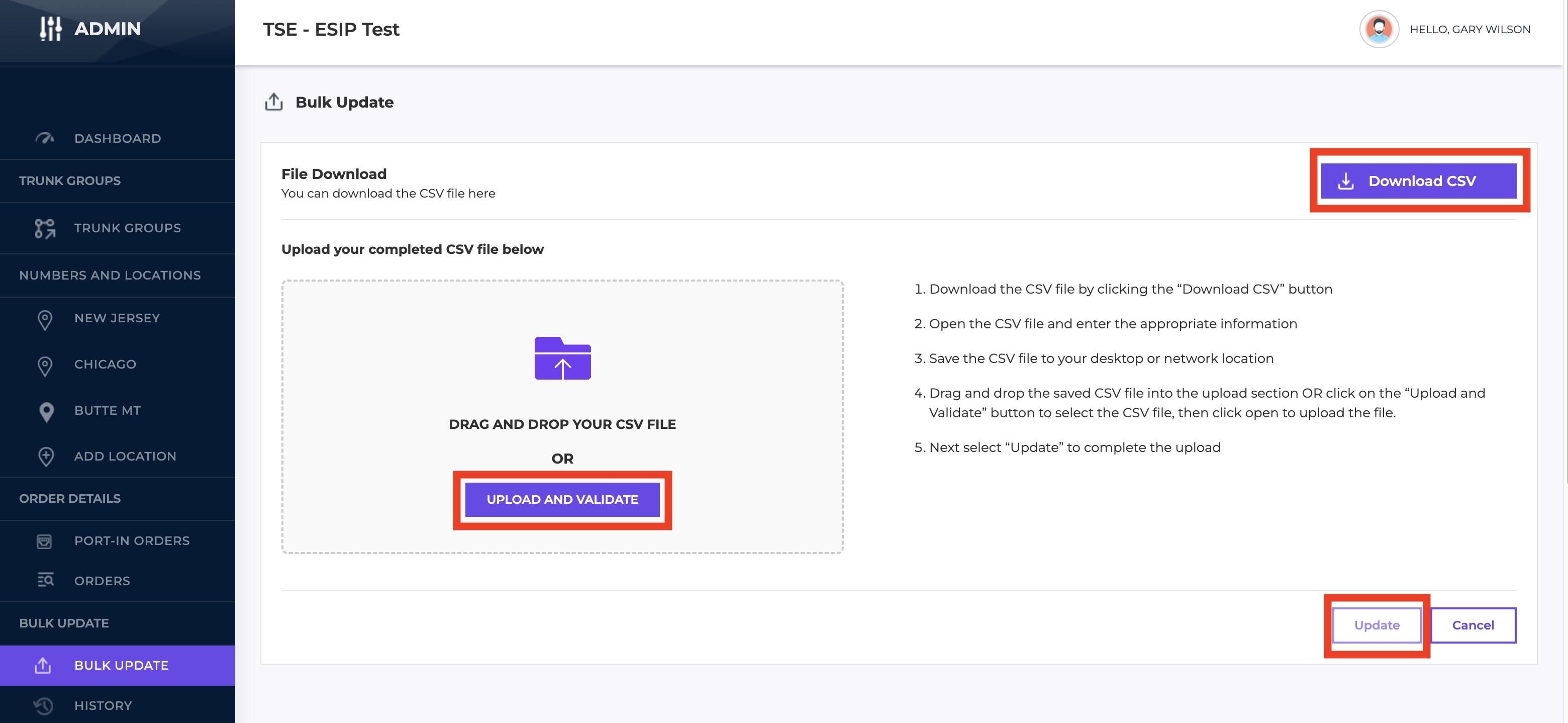
The process begins by selecting Download CSV and entering your email address; it will use the account email by default, but this can be changed.
You’ll receive an email with a CSV document with your organization's numbers and settings. The CSV file will contain many of the options you see when you individually edit a number.
The first columns are for reference:
- DID (this applies to TF as well)
- RATECENTER (not applicable to Toll Free so this will be blank)
- STATE (not applicable to Toll Free so this will be blank)
- DID_TYPE (either TF or LC)
Do not change these values since these are used to identify exactly which number you are changing.
The next columns are in groups and let you change the following:
- Outbound Calling Name
- OUTBOUND_CALLER_NAME_ENABLED - Y/N
- OUTBOUND_CALLER_NAME_ENABLED (enter the up to 15 character name you want for the outbound caller name (CNAM)
- E911
- E911_ENABLED (Y/N)
- E911_EMERGENCY_CONTACT
- E911_STREET_NUM
- E911_STREET_NAME
- E911_CITY
- E911_STATE
- E911_EMERGENCY_RESPONSIVE_LOCATION
- E911_ZIP_CODE
- INT_CALLING_ENABLED (used to enable inbound for a number if allowed - Y/N
- LOCATION - (Billing Location Name)
- TRUNK_GROUP (Trunk group name if a Local Number (DID) - blank otherwise)
- ROUTE_LABEL (Route label name if a TF number - blank otherwise)
Note that when you download this file, it will contain all of your current numbers. If you only want to apply changes to certain numbers, delete the rows for all the numbers you don't want to change and only import the rows of numbers you do want to change.
Once done, return to the dashboard and select Upload and Validate. After validation has been completed, you will then click Update to process all requested changes.
History
You can view all previous bulk updates by selecting History under the Bulk Update menu heading.
Account
The Account menu heading contains several options to manage users, monitor usage, view bills, and create support tickets.
User
The User menu allows you to create additional users at your company that you may want to help manage your account. Select Users under the Account menu heading to view all active users. To add users, click Add New User in the upper right.
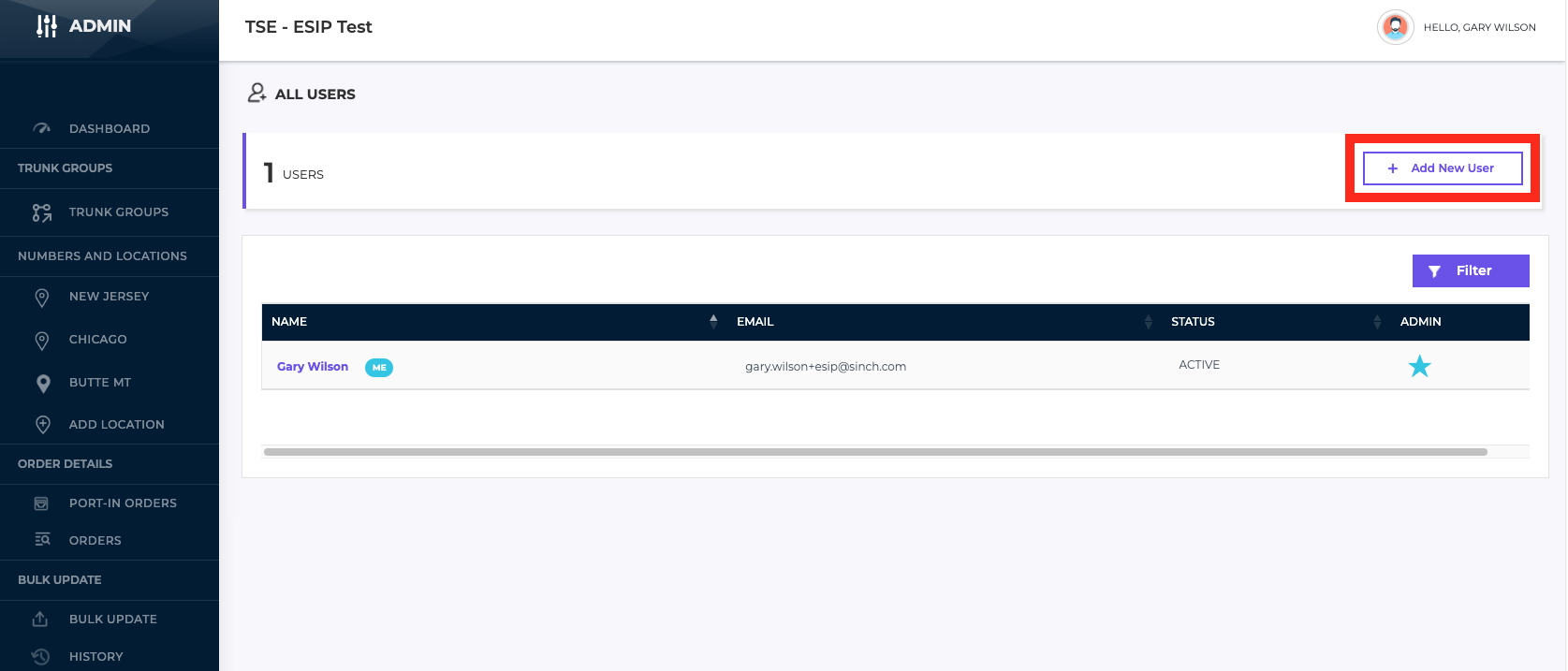
Click + Add New User to invite a new user to view the dashboard. Check the Admin Access box if they will require administrative access to help managed the account; otherwise, leave it unchecked to provide read-only access. Select Send Invitation once complete.
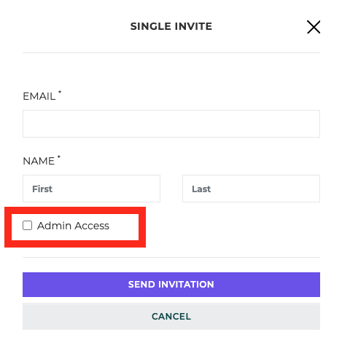
Selecting an existing user will provide a similar pop-up to allow you to modify the user’s email address, name, or change admin access rights. Modifying an existing user also includes a Deactivate User option.
Call Logs
All calls made through our SIP trunking services are logged. You can view completed calls by selecting Call Logs under the Account menu heading. Select the calendar to create a custom date range and click Apply. You can also input From Number and/or To Number to view calls specific to those numbers. Finally, click Search to have results displayed on the page, or select Download CSV to receive a CSV file with the requested data.
